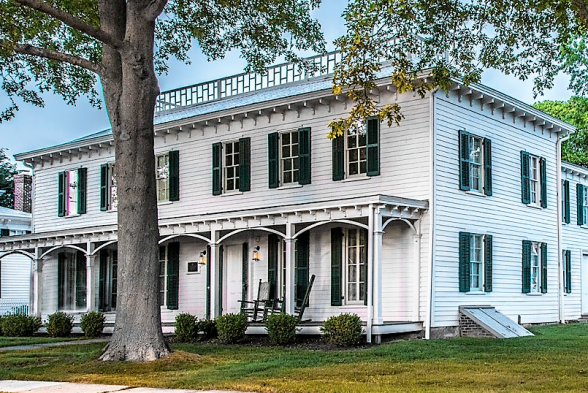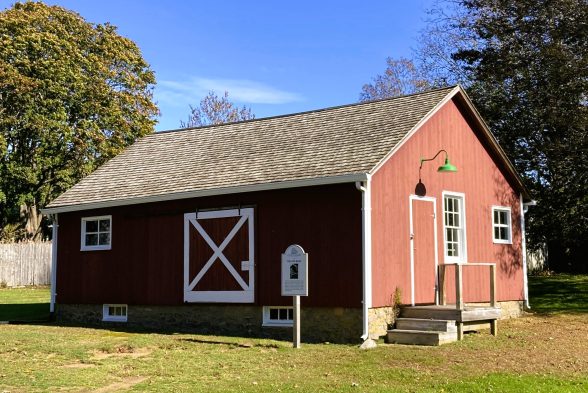History of Our Buildings
Samuel Vail House
Vail House was built in the last quarter of the 19th century. On June 25, 1920, Samuel Gilson Vail purchased the house and property for $1. Vail–who was related to the family who owned OHS’s centerpiece, the Village House–worked as a fisherman on the Black Eagle. Vail died in April of 1971 and OHS purchased the property and furnishings from his estate in 1972. In 2019 the building was re-purposed as office space.
In 2022, The OHS Board of Trustees approved a project to build an up-to-date archival collections center as an addition to Vail House.

Village House
Imagine arriving at the Orient wharf by steamboat and strolling down the street in this fashionable summer resort. Built in 1798 and substantially enlarged in the 1850s, Village House today is open to the public decorated as it was when it welcomed visitors as a boarding house long ago. Upstairs, the bedrooms have been converted into six exhibition galleries, which are open to the public. Village House also features the Beach Plum Shop with books about local history, souvenirs, and unique craft items created here on the North Fork.

Webb House
The Webb House, an elegant example of early American architecture, was built in the late 18th century in what is now Greenport and probably served as an inn. The building was moved in the first part of the 19th century from its original site to the King’s Highway (now Route 25) where it was used as a farmhouse. In 1955 it was moved again – this time by barge – to Orient and became part of OHS in the 1980s. Webb House today is open to the public and decorated and period-furnished as it was during its late-18th and 19th century heyday. A Maritime Exhibition is on permanent display on the 2nd floor.

Old Point Schoolhouse
The Old Point Schoolhouse, originally called the “Down-Neck School,” was built in 1873 to serve the community living near Orient Point. Closed in 1930 for lack of students, it lost its cupola in the great hurricane of 1938. In 1949, OHS acquired the building as a gift from Orient resident Edwin King and moved it to its current location. Today, the main floor of the Schoolhouse features the Janet T. Swanson Exhibition Gallery which houses an annual exhibition culled from OHS’s exceptional collection of historic artifacts, documents, diaries, works of art, and archival objects dating from early Native American times all the way through the 20th century.

Amanda Brown Schoolhouse
Once a wing of a house near the Orient Village Cemetery (across from the current Oysterponds Elementary School), this small building was used as a private school, taught by Miss Amanda Brown, beginning in 1862. Later, the main house to which the school was joined was moved, and this remaining section served as a tea-room and gift shop. In 1939, the schoolhouse was moved to the grounds of the Orient Point Inn and subsequently moved to the OHS campus in 1971.

Hallock Building
Built in 1891, the Hallock building served as a cookhouse and dormitory for workers on the large Hallock Farm in Orient. Acquired by the Society and moved to its present site in 1960, the structure has been restored and now contains the Donald H. Boerum Research Library and an archival research center, both open to the public by appointment only. Hallock Building also currently houses most of the Society’s collections as well as offices for the Curator and Collections Manager.

Red Barn
The 19th century Red Barn was built originally as a grain storage shed located on the Orient Wharf and subsequently moved 750 feet to its present location on the OHS campus. In the most recent past, the building stored some of the larger scale objects in OHS’s collections, including horse-drawn carriages and sleighs.
In 2024 it was revitalized and repurposed and is now home to the multi-media Red Barn Collection, a permanent exhibition focusing on the storied farming and fishing history of Long Island’s North Fork.

top


